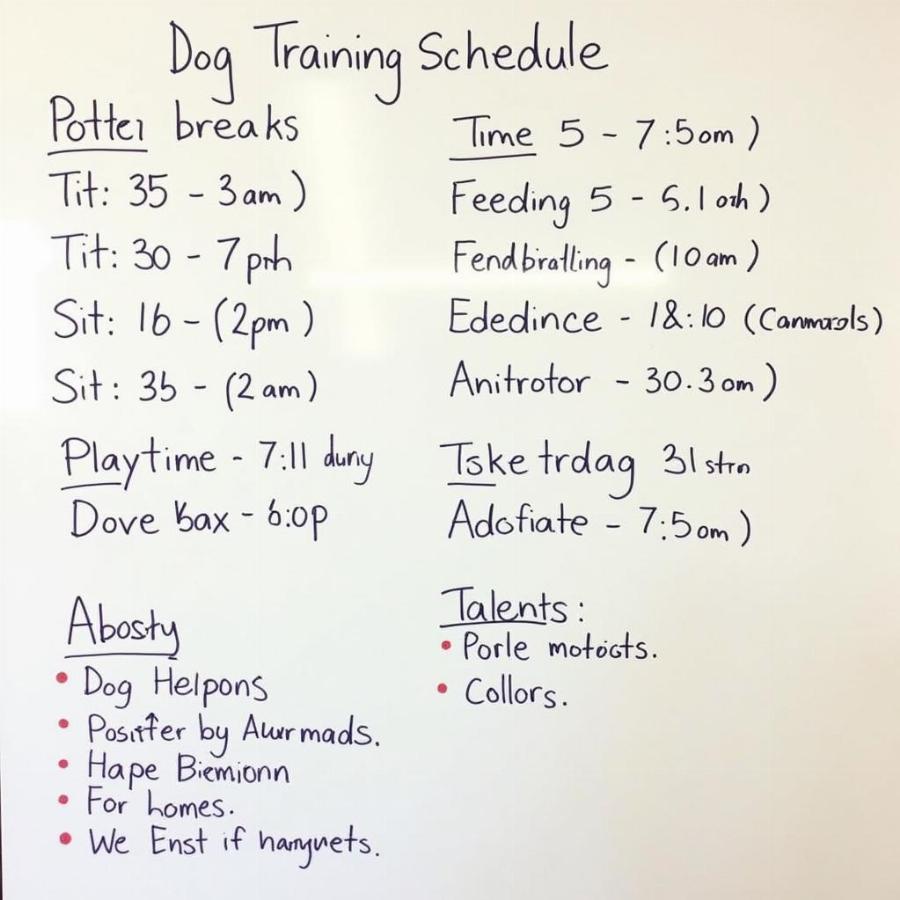A well-behaved dog is a joy to be around, and a solid dog training plan is the key to achieving that. Whether you have a playful puppy or an adult dog needing some guidance, a structured approach to training can make the process smoother and more effective. This comprehensive guide will provide you with the essentials to create a dog training plan tailored to your dog’s specific needs and your lifestyle.
Creating a Personalized Dog Training Plan
A dog training plan isn’t a one-size-fits-all solution. It needs to consider your dog’s breed, age, temperament, and any pre-existing behaviors. Just as importantly, it needs to fit into your schedule and resources. A realistic plan will have a higher chance of success. Begin by identifying your training goals. Are you aiming for basic obedience, tackling specific behavioral issues, or striving for advanced tricks? Clearly defined goals will give your plan direction.
 Dog Training Schedule Example
Dog Training Schedule Example
Next, break down your overall training goals into smaller, achievable steps. Instead of aiming for “perfect recall” immediately, start with short-distance recall in a quiet environment. This approach will build both your dog’s confidence and your own. Remember to incorporate positive reinforcement methods into your plan. Rewards, whether they’re treats, praise, or a favorite toy, motivate your dog and make training a positive experience.
Choosing the Right Training Methods
Different dogs respond to different training methods. Positive reinforcement, using rewards to encourage desired behaviors, is generally considered the most effective and humane approach. Clicker training, a form of positive reinforcement, can be particularly helpful for teaching specific commands. Avoid punishment-based methods, as these can create fear and anxiety, damaging your bond with your dog.
Consistency is crucial. Establish a regular training schedule, even if it’s just for short periods each day. Short, frequent sessions are often more effective than long, infrequent ones, especially for puppies and dogs with short attention spans. Remember to stay patient. Training takes time and effort, and there will be setbacks. Celebrate small victories and stay positive throughout the process.
Addressing Common Dog Training Challenges
Housebreaking accidents, excessive barking, leash pulling – these are just a few common challenges dog owners face. A good dog training plan proactively addresses these potential issues. For example, my dog keeps urinating on my bed offers advice on tackling this frustrating problem. Similarly, incorporating leash training early on can prevent future pulling issues. For those dealing with barking, best bark collar for small dog provides helpful information on choosing the right tool for your furry friend. By anticipating and planning for these challenges, you’ll be better equipped to handle them when they arise.
How can I create a dog training schedule that works for me?
A good starting point is to dedicate 10-15 minutes twice a day to training. Integrate these sessions into your daily routine, such as after mealtimes or before walks. This creates a consistent and predictable experience for your dog.
What are the most important things to include in a dog training plan?
Your plan should include clear training goals, a breakdown of those goals into smaller steps, chosen training methods, a consistent schedule, and strategies for addressing potential challenges like housebreaking or excessive barking.
What if my dog isn’t responding to the training plan?
Don’t get discouraged. Sometimes, adjustments are needed. Re-evaluate your methods, consider seeking guidance from a professional dog trainer, and remember that patience is key.
Conclusion
A comprehensive dog training plan is an investment in your dog’s well-being and your relationship together. By following these steps and tailoring your approach to your dog’s individual needs, you’ll be well on your way to a happy, well-behaved companion. Remember, consistency and positive reinforcement are key. Start your dog training plan today and enjoy the rewards of a well-trained dog! For advice on choosing the perfect breed for your lifestyle, check out best dog breeds for traveling. If you are in Wilmington, NC and seeking professional assistance, dog training wilmington nc is a valuable resource.
FAQs
- How often should I train my dog? Short, daily sessions (10-15 minutes, twice a day) are ideal.
- What are the best rewards to use? Treats, praise, and toys can all be effective.
- When should I start training my puppy? As early as possible, ideally around 8 weeks old.
- What if my dog has behavioral issues? Consult with a professional dog trainer for personalized guidance.
- Is clicker training effective? Yes, it can be a very effective form of positive reinforcement.
Beaut Dogs is your one-stop resource for all things dog-related, from breed information to training tips. We provide expert advice and helpful resources to help you navigate the joys and challenges of dog ownership. When you need expert advice, don’t hesitate to contact us at Email: [email protected] for detailed and accurate answers. Beaut Dogs is here to support you every step of the way. Visit https://beautdogs.com today!